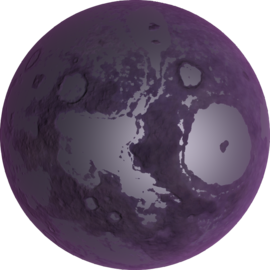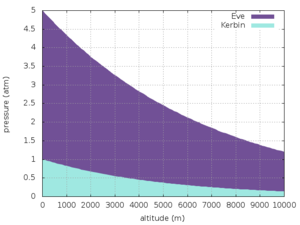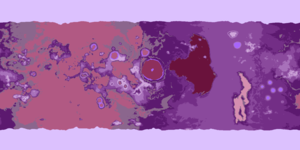Difference between revisions of "Eve"
(→Atmosphere) |
m (-uppercase in titles;) |
||
| Line 3: | Line 3: | ||
'''Eve''' is the second [[planet]] from [[Kerbol]], the closest planet to [[Kerbin]], and KSP's analogue for [[w:Venus|the planet Venus]]. It has one small moon: a captured asteroid called '''[[Gilly]]'''. Mainly because of the atmosphere it's the hardest planet to return from after landing. Additionally, it has the highest surface gravity in the game, and the second highest radius (only Jool's radius is larger). Aerobraking on Eve is also more deadly due to its dense atmosphere, which means spacecraft are more likely to explode due to overheating before reaching land. | '''Eve''' is the second [[planet]] from [[Kerbol]], the closest planet to [[Kerbin]], and KSP's analogue for [[w:Venus|the planet Venus]]. It has one small moon: a captured asteroid called '''[[Gilly]]'''. Mainly because of the atmosphere it's the hardest planet to return from after landing. Additionally, it has the highest surface gravity in the game, and the second highest radius (only Jool's radius is larger). Aerobraking on Eve is also more deadly due to its dense atmosphere, which means spacecraft are more likely to explode due to overheating before reaching land. | ||
| − | ==In-game | + | ==In-game description == |
{{Quote | {{Quote | ||
| Line 71: | Line 71: | ||
From within Eve's atmosphere, the sky appears indigo during nighttime and a violet-purple color during daytime. During dawn and dusk, the sky is green. | From within Eve's atmosphere, the sky appears indigo during nighttime and a violet-purple color during daytime. During dawn and dusk, the sky is green. | ||
| − | === Atmospheric | + | === Atmospheric flight === |
The thickness of Eve's atmosphere makes it suitable for [[aerobraking]] and the use of [[parachute]]s. Jet engines do not function in Eve's atmosphere, since it contains no oxygen — they make noise and consume fuel, but they produce no thrust. Planes with other propulsion methods do, however, work very well, and are a great way to explore the planet. They work best between 35 km and 25 km where the atmosphere generates enough lift to glide and steer, but not enough drag to slow the aircraft excessively. | The thickness of Eve's atmosphere makes it suitable for [[aerobraking]] and the use of [[parachute]]s. Jet engines do not function in Eve's atmosphere, since it contains no oxygen — they make noise and consume fuel, but they produce no thrust. Planes with other propulsion methods do, however, work very well, and are a great way to explore the planet. They work best between 35 km and 25 km where the atmosphere generates enough lift to glide and steer, but not enough drag to slow the aircraft excessively. | ||
| Line 150: | Line 150: | ||
For a semisynchronous orbit of ½ Eve day (11.25 hours or 40500 seconds) an orbit of 6275.676 km above Eve is needed with a velocity of 1082.2 m/s. | For a semisynchronous orbit of ½ Eve day (11.25 hours or 40500 seconds) an orbit of 6275.676 km above Eve is needed with a velocity of 1082.2 m/s. | ||
| − | == Reference | + | == Reference frames == |
{{:Eve/RefFrame}} | {{:Eve/RefFrame}} | ||
Revision as of 16:55, 21 May 2015
| Eve | ||
| Eve as seen from orbit. | ||
| Planet of Kerbol | ||
| Orbital Characteristics | ||
| Semi-major axis | 9 832 684 544 m [Note 1] | |
| Apoapsis | 9 931 011 387 m [Note 1] | |
| Periapsis | 9 734 357 701 m [Note 1] | |
| Orbital eccentricity | 0.01 | |
| Orbital inclination | 2.1 ° | |
| Argument of periapsis | 0 ° | |
| Longitude of the ascending node | 15 ° | |
| Mean anomaly | 3.14 rad (at 0s UT) | |
| Sidereal orbital period | 5 657 995 s | |
| 261 d 5 h 39 m 55.1 s | ||
| Synodic orbital period | 14 687 035.5 s | |
| Orbital velocity | 10 811 - 11 029 m/s | |
| Physical Characteristics | ||
| Equatorial radius | 700 000 m | |
| Equatorial circumference | 4 398 230 m | |
| Surface area | 6.1575216×1012 m2 | |
| Mass | 1.2243980×1023 kg | |
| Standard gravitational parameter | 8.1717302×1012 m3/s2 | |
| Density | 85 219.677 kg/m3 | |
| Surface gravity | 16.7 m/s2 (1.701 g) | |
| Escape velocity | 4 831.96 m/s | |
| Sidereal rotation period | 80 500.000 s | |
| 3 d 4 h 21 m 40 s | ||
| Solar day | 81 661.857 s | |
| 3 d 4 h 41 m 1.9 s | ||
| Sidereal rotational velocity | 54.636 m/s | |
| Synchronous orbit | 10 328.47 km | |
| Sphere of influence | 85 109 365 m [Note 1] | |
| Atmospheric Characteristics | ||
| Atmosphere present | Yes | |
| Atmospheric pressure | 506.625 kPa | |
| 5 atm | ||
| Atmospheric height | 90 000 m | |
| 5.0×10-6 atm | ||
| Temperaturemin | -113.13 °C 160.02 K | |
| Temperaturemax | 146.85 °C 420 K | |
| Oxygen present | No | |
| Scientific multiplier | ||
| Surface | 8 | |
| Splashed | 8 | |
| Lower atmosphere | 6 | |
| Upper atmosphere | 6 | |
| Near space | 7 | |
| Outer space | 5 | |
| Recovery | 5 | |
|
| ||
Eve is the second planet from Kerbol, the closest planet to Kerbin, and KSP's analogue for the planet Venus. It has one small moon: a captured asteroid called Gilly. Mainly because of the atmosphere it's the hardest planet to return from after landing. Additionally, it has the highest surface gravity in the game, and the second highest radius (only Jool's radius is larger). Aerobraking on Eve is also more deadly due to its dense atmosphere, which means spacecraft are more likely to explode due to overheating before reaching land.
Contents
In-game description
| “ | Eve is certainly the purplest object in the solar system. Its one of the larger, most visible objects, mainly because of its very, very purple tint. It is considered by some to be an almost sister planet to Kerbin. Well, despite the purple, and the toxic atmosphere, and the extreme pressures and temperatures… Actually, it’s not very similar at all is it? Who are these people? — Kerbal Astronomical Society |
” |
Topography
The surface of Eve looks not unlike that of Saturn's largest moon, Titan. It has several oceans, among which lie large, flat continents. The terrain has a few mountain peaks, but mostly consists of rolling hills that resemble purple sand dunes. These are speckled with small boulders, no doubt worn down by Eve's pressure, temperature, and wind. Eve's surface is covered with craters. The composition of the violet liquid which fills the oceans and lakes is unknown, although water remains a possibility: the boiling point of water is slightly higher than the surface temperature when taking the high atmospheric pressure into account.[1] According to the devs during a livestream, it was joked that the lakes were made of rocket fuel[citation needed]. Eve's highest mountain range has a peak of 7526 m.
Atmosphere
Eve has an extremely dense atmosphere with a mass of approximately 1.9×1017 kilograms, a sea level pressure of 506.625 kilopascals (5 atmospheres), and a depth of 90,000 meters. Compared to the atmsophere of Kerbin, Eve's atmosphere has 4 times the mass and 5 times the sea level pressure. At an altitude of 10,577 m, Eve's atmospheric pressure is the same as Kerbin's atmosphere at sea level (1 atm). The pressure at the top of Eve's highest mountain peak is 1.5 atm.
The average molecular weight of Eve air is 43 g/mol, and its adiabatic index is 1.20. Although the composition of Eve's atmosphere is unknown, these values suggest that it may consist largely of carbon dioxide.
Like all other atmospheres in the game, Eve's atmosphere fades exponentially as altitude increases. The scale height varies with altitude, which is a change from pre-1.0 versions of the game. The pressure-altitude profile is globally constant and independent of temperature. The following table gives the atmospheric pressure at various altitudes above sea level.
| Altitude (m) | Pressure (Pa) |
|---|---|
| 0 | 506 625 |
| 2 500 | 329 212 |
| 5 000 | 217 760 |
| 7 500 | 151 432 |
| 10 000 | 109 422 |
| 12 500 | 77 912 |
| 15 000 | 54 946 |
| 20 000 | 29 097 |
| 25 000 | 16 452 |
| 30 000 | 8 314 |
| 35 000 | 3 669 |
| 40 000 | 1 508 |
| 50 000 | 559.4 |
| 60 000 | 214.5 |
| 70 000 | 59.71 |
| 80 000 | 5.512 |
| 90 000 | 0 |
The surface of Eve is very hot, with a globally averaged sea level temperature of approximately 135 oC. Except for a small inversion layer between 50-60 km at low latitudes, air temperatures decrease with increasing altitude up to an altitude of 70 km. Above 70 km, the rarified atmosphere warms as altitude increases. Despite the hot surface temperatures, the lack of a stratosphere means that Eve's atmosphere is cooler than Kerbin's at altitudes above ≈26.5 km. The temperature rise above 70 km suggests the presence of a thermosphere.
Air temperatures vary with latitude and time of day. At the equator, sea level temperatures vary between a nighttime low of 147 oC and a daytime high of 156 oC. At the poles, the temperature varies between 87 oC and 95 oC. Since Eve has no axial tilt, there are no seasonal temperature variations.
From within Eve's atmosphere, the sky appears indigo during nighttime and a violet-purple color during daytime. During dawn and dusk, the sky is green.
Atmospheric flight
The thickness of Eve's atmosphere makes it suitable for aerobraking and the use of parachutes. Jet engines do not function in Eve's atmosphere, since it contains no oxygen — they make noise and consume fuel, but they produce no thrust. Planes with other propulsion methods do, however, work very well, and are a great way to explore the planet. They work best between 35 km and 25 km where the atmosphere generates enough lift to glide and steer, but not enough drag to slow the aircraft excessively.
Landing legs on Eve can easily break because of Eve's high gravity and, surprisingly enough, atmospheric pressure.
Science
Eve's orbit and atmosphere have a science multiplier of 7, which is rather average. But the surface has a multiplier of 12, which is the third highest science multiplier in the whole star system. Eve has 7 biomes with their own science to be collected. It has several Explodium Seas, among which lie large continents.
Biome list
|
Natural satellites
Eve's only natural satellite is the tiny captured asteroid Gilly in a highly eccentric and inclined orbit. Gilly is the smallest celestial body in the Kerbol system.
Orbital statistics
Visiting Eve potentially requires the least delta-v of any planet because its huge gravity well and dense atmosphere mitigate the difficulties that its slight relative inclination poses and greatly ease aero-captures, transfers, and landings; unfortunately, takeoff and escape therefore require the most delta-v of any celestial body with a solid surface.
The combination of high gravity and thick atmosphere makes return missions from the sea level of Eve very difficult. It requires about 11,500 m/s of delta-v to get into orbit from sea level. Driving to and launching from the peak of one of Eve's mountains can drastically reduce the amount of delta-V required (thus allowing successful launches with significantly lighter rockets). The highest peak on Eve since version 0.21.1 is 7540 m high, found near (25° S, 158.5° W)
| Altitude (m) | Delta-V Required (m/s) |
|---|---|
| 0 | 11,282 |
| 1000 | 10,731 |
| 2000 | 10,219 |
| 3000 | 9,743 |
| 4000 | 9,300 |
| 5000 | 8,888 |
| 6000 | 8,507 |
| 7000 | 8,150 |
| 7540 | 7,968 |
A synchronous orbit of Eve requires an altitude of 10373.195 km and a velocity of 858.95 m/s. For a semisynchronous orbit of ½ Eve day (11.25 hours or 40500 seconds) an orbit of 6275.676 km above Eve is needed with a velocity of 1082.2 m/s.
Reference frames
| Time warp | Minimum Altitude |
|---|---|
| 1× | Any |
| 5× | 90 000 m (above the atmosphere) |
| 10× | 90 000 m (above the atmosphere) |
| 50× | 90 000 m (above the atmosphere) |
| 100× | 120 000 m |
| 1 000× | 240 000 m |
| 10 000× | 480 000 m |
| 100 000× | 600 000 m |
Gallery
Bugs
- Eve has higher gravity than Kerbin, restricting a Kerbal's jump to only half a meter and making EVA jets useless. This being said, if a Kerbal falls from more than 4 m, they will hit the ground much harder than on Kerbin, which may cause a glitch to happen in which they will clip into the terrain and accelerate away from Eve at phenomenal speed, sometimes faster than the speed of light itself, usually sending the unlucky Kerbal on an escape trajectory from Kerbol if they are not killed by the fall. They may bring something into interstellar space with them if they hit an object instead of the ground.
- Solar panels will probably break off in flight, even with very low velocity. It's best to wait to extend them till stable on the surface, however they can break on the surface of Eve even when retracted. This may be due to Eve's high gravity.
- Rovers can be challenging to drive on Eve due to its gravity. The rover's wheels will easily break, but on the upside, since the gravity pulls them lower on their shocks and thus lowers the centre of mass, they will be harder to flip over. Although not a glitch, it could cause clipping issues with a kerbals sitting in EAS-1 External Command Seats
- When landing fast, craft will sometimes sink into the surface of Eve. This can be fixed by using landing legs to lift the ship up.
Changes
- Added biomes
- Terrain Tweaks — more land mass to the surface
- Art pass.
- Terrain tweaks — the tallest points are now about 6 km in altitude, compared to 11 km before.
- Initial Release
Notes
- ↑ According to WolframAlpha the boiling temperature is about 2.5 K higher than the highest temperature measured.















